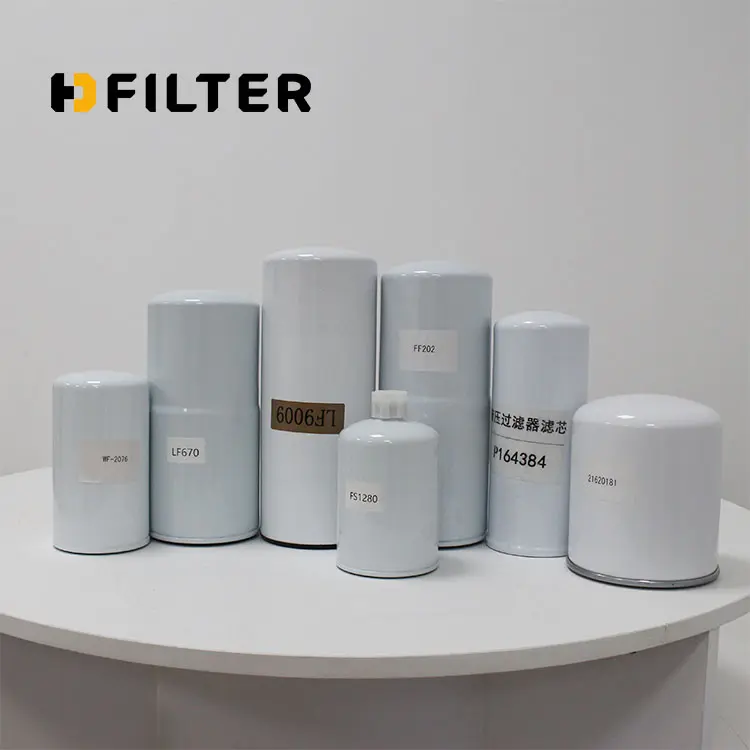Differences in Materials of Filters at Various Price Points
Filters are critical components in machinery, particularly for equipment such as excavators, loaders, bulldozers, and trucks. They protect engines
and hydraulic systems by trapping contaminants, ensuring optimal performance and longevity. However, filters come in a wide range of prices,
often reflecting differences in materials used. This article explores these material differences, providing a clear comparison supported by reliable
data sources.
1. Basic Low-Cost Filters
Low-cost filters are typically made from inexpensive materials to meet minimal performance requirements.
Filter Media: Low-cost filters often use cellulose-based paper, which is cost-effective but offers limited filtration efficiency. For instance,
cellulose filters typically achieve filtration efficiency between 50-80% for particles as smallas 20 microns .
Structural Components: The housing and end caps in these filters are usually constructed from basic steel or low-grade plastic. These
materials may lack durability under extreme operating conditions, potentially leading to deformation or cracking.
Applications: These filters are best suited for light-duty applications where high filtration efficiency is not critical.
2. Mid-Range Filters
Mid-range filters strike a balance between cost and performance, utilizing moderately advanced materials.
Filter Media: Synthetic blends or cellulose-synthetic composites are common. These materials provide enhanced filtration efficiency (70-95%
for particles as small as 15 microns) and extended service life compared to purely cellulose-based filters .
Structural Components: The housing is often reinforced steel or high-quality plastic, making these filters more resistant to extreme pressures
and temperatures.
Additional Features: Mid-range filters frequently include anti-drain-back valves or pressure-relief valves to improve reliability in various
operating conditions.
Applications: These filters are ideal for medium-duty equipment and vehicles requiring moderate performance standards.
3. Premium High-Cost Filters
High-cost filters are designed for maximum efficiency and durability, utilizing the most advanced materials and technologies.
Filter Media: Premium filters often feature micro-glass or fully synthetic media, offering superior filtration efficiency of up to 99.9% for particles
as small as 5 microns . The multi-layer design ensures extended service intervals and excellent contaminant-holding capacity.
Structural Components: Premium filters use high-strength, corrosion-resistant metals and advanced polymers. These materials provide
unmatched durability in harsh environments, such as extreme heat or heavy vibrations.
Additional Features: Premium filters frequently include features such as integrated sensors, multi-layer filtration stages, or enhanced sealing
mechanisms to prevent leaks.
Applications: They are best suited for heavy-duty machinery operating in demanding environments where downtime or failure is costly.
Comparative Overview
Price Range | Filter Media | Efficiency | Durability | Applications |
Low-Cost | Cellulose-based paper | 50-80% (20 microns) | Basic | Light-duty equipment |
Mid-Range | Synthetic-cellulose blend | 70-95% (15 microns) | Moderate | Medium-duty equipment |
High-Cost | Micro-glass/synthetic media | 99.9% (5 microns) | Exceptional | Heavy-duty machinery |
Factors to Consider When Choosing a Filter
Application Requirements: The operational demands of the equipment should guide the choice of filter material. Heavy-duty machinery
requires high-efficiency filters, while light-duty equipment may suffice with basic filters.
Operating Environment: Filters used in dusty or extreme conditions should have advanced materials to ensure reliability.
Lifecycle Costs: While premium filters have higher upfront costs, they often provide better value by extending service intervals and reducing
equipment wear.
Conclusion
Understanding the material differences in filters across price ranges allows for informed decision-making based on specific needs and budgets.
By balancing cost with performance requirements, equipment operators can ensure optimal machinery performance and longevity. For further
details and verification of the data provided, consult the referenced sources linked a bove.














